|
This is one of a series of sundial trailsdesigned to help visitors to
find good and interesting sundials to see in areas unfamiliar to them.
Follow the links for a list of our pages for other places in
the complete list of Sundial Trails, divided by country.
This trail was developed bymembers of the British Sundial Society and
Museum staff The Horniman is in London Road, Forest Hill, London, SE23;
it has an extensive ethnographical collection, a fine collection of
musical instruments, and the best collection of sundials of many different
types on one site anywhere in England. So it is well worth a visit to
see all these dials! A free trail leaflet is obtainable at the information
desk
The sundials are set up close to the main entrance to the Museum, and
in the prize-winning Horniman Gardens. You can find more pictures of
these magnificent sundials on the Forest Hill community website at www.foresthill.org.uk/sundials.html
Explanatory Plaque
 |
This tells you how to obtain clock time from
the time shown by the sundial. the difference is due to the tile
of the earth and is irregular orbit around the sun. In summer,
you also have to allow an extra hour |
-
Stained Glass Vertical Dial
| On the glass wall of the Conservatory, this
dial faces slightly West of South. Designed to be read from
inside, the orientation of the hour lines are the reverse of
the normal wall dial (here a.m. hours are on the right and p.m.
on the left). The gnomon is placed outside to project a shadow
which can be read all round the centre section. The central
section (12) is coloured green to represent the gardens. The
outer blue panels represent the various departments of the Museum.
Designer and maker: Roselyn Loftin - Delineator: David Young)
|
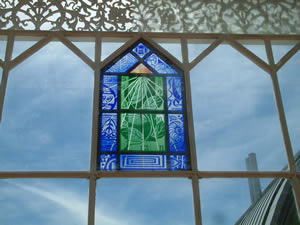 |
Roman Sundial
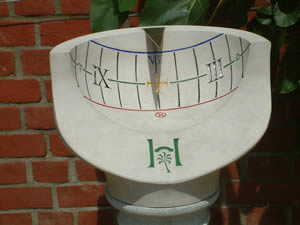 |
This dial has been designed and constructed
by David Brown after the style of a typical Roman timepiece.
Originally created for a different time system, it has been
specially delineated to read the sort of hours we all use today.
|
-
Tea time dial
| On a brick wall facing slightly north
of west, this dial captures the summer afternoon hours and is
calibrated for BST, unlike most of the other dials here. Sited
by the tea garden so you can check your watch while sipping
Earl Grey. Designed and erected by John Moir and David Young.
|
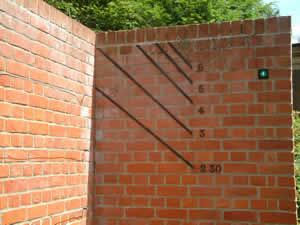 |
"Butterfly" Horizontal Dial
 |
This dial was originally designed for the
Sunday Express Garden at the Chelsea Flower Show. (Design: Edwin
Russell - Construction: Brookbrae Ltd., London) |
"Spot-On" Stainless Steel Horizontal Dial
| The innovative Spot-On Sundial
has a narrow slit in the gnomon (which casts the shadow). This
produces a "line of light" (shown in the right hand picture)
for about five minutes when the sun is at its highest at noontime.
This feature makes it particularly easy to align the sundial
accurately to true north, and thus to read the sundial to within
a minute or two. Spot-On sundials are made in a variety of sizes
in stainless steel and in brass. For further details, please
see www.spot-on-sundials.co.uk
|
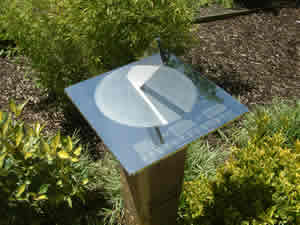 |
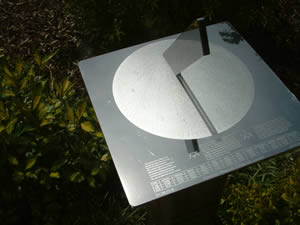
|
-
Equatorial Dial
| A shapely dial of a type from which most
other dials represented here are derived. Designed and made
by Silas Higgon of Connoisseur
Sundials. |
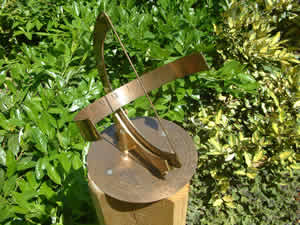 |
Horniman Horizontal Dial
 |
This dial commemorates the Centenary of
the opening of the gardens to the public in 1897. The gnomon's
shape derives from the Horniman "H" and the name of Horniman
is written in place of the 9 and 7 hour lines (1897). This however,
may escape notice, except for the few visitors who know their
Morse Code! (Designed by John Moir and constructed by Ray Ashley)
|
Horniman Logo Double Polar Dial
| A Polar dial has both the gnomon
and the dial plate parallel to the earth's Polar axis. The Horniman
dial is, in effect, two separate polar dials, with two gnomons
and two overlapping hour scales In basing the dial on the Horniman
Logo the aim was to make no changes other than the addition
of the hour marks. Even the words "The Horniman Museum and Gardens"
are preserved - their 27 letters rearranged to provide a motto
"and hours run mad, e'en as men might". Dial Design: John Moir
- Construction and Plinth Design: Richard Klose. |
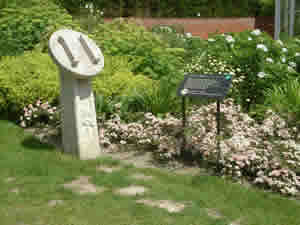 |
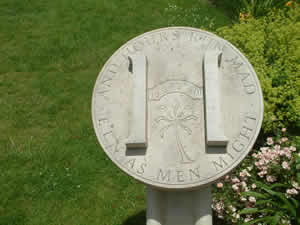
|
-
"Scaphe" or Bowl Sundial
|
The perfect inner bowl of this sundial contrasts with the
disorganised, decaying appearance of the outer bowl and stem.
The stem's shape was inspired by the Magnolia X soulangiana
in the water garden. The bowl is part of a sphere. The
gnomon sits inside this bowl and points towards the centre
of the sphere. The shadow of the gnomon's tip falls on the
hour lines and shows solar time. (Designed by Angela Hodgson of the St Martins School of art, delineated by Dick Andrewes)
|
 |
-
Analemmatic Sundial
- This sundial is sited with Mr. Horniman's house once stood. The
gnomon is the observer who casts a shadow onto the horizontal scale.
Instead of hour lines, it has an elliptical arrangement of slabs,
acting as hour points. There is also a central pavement, aligned N-S,
on which months are marked. By standing on the current month, you
can read the time from your own shadow, which is cast on to or between
the numbered slabs (see diagram). (Design: Barry Small - Construction:
Horniman Gardens Staff)
-
Ceiling dial
-
This rare type of dial is in the library at the CUE building.
Here,light from the sun is reflected from a small mirror to produce a
light spot on a large hour scale, indicating solar time. Transverse
lines in blue, red and black mark the winter and summer solstices and
the two equinoxes. The dial works well except when the low midwinter
sun's direct rays reduce the contrast of the reflected light spot. Dial
by Ray Ashley and John Moir.
|
 For
a full overview click
here
For
a full overview click
here  For
a full overview click
here
For
a full overview click
here